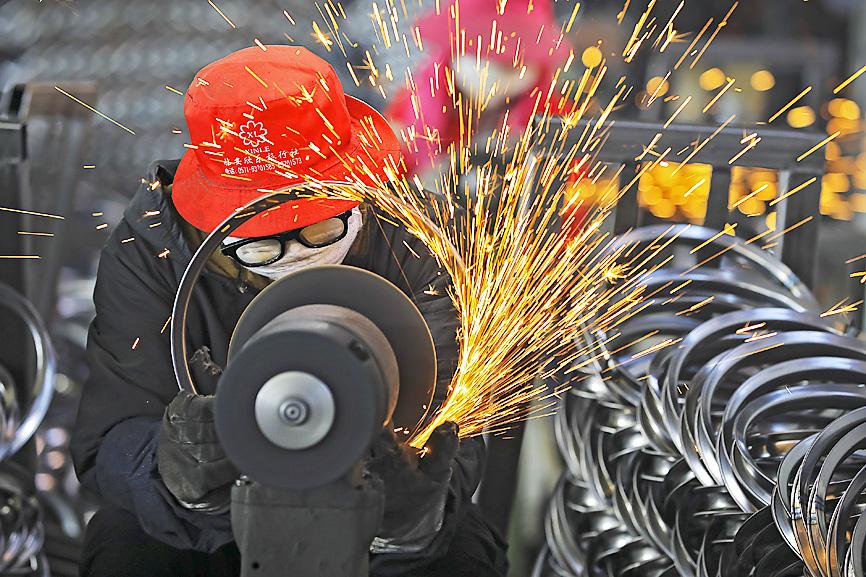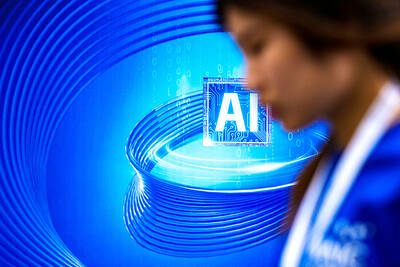Solid demand for technology goods drove extended growth in Asia’s factories last month, but a slowdown in China underscored the challenges facing the region as it seeks a sustainable recovery from the shattering COVID-19 pandemic blow.
The vaccine rollouts globally and a pickup in demand provided optimism for a vast number of businesses that had grappled for months with a cash flow crunch and falling profits.
In Japan, manufacturing activity expanded at the fastest pace in more than two years, while South Korea’s exports rose for a fourth straight month last month, suggesting the region’s export-reliant economies were benefiting from robust global trade.

Photo: AP
On the flip side, China’s factory activity grew at the slowest pace in nine months, hit by a domestic flareup of COVID-19 and soft demand from countries under renewed lockdown measures.
“In all, the softer pace of activity in today’s [Chinese] manufacturing print is likely to be temporary, and we expect the growth momentum to pick up on the back of a broadening out of the domestic demand recovery and a pickup in global demand,” HSBC Holdings PLC economist Erin Xin said.
“However, household consumption, while recovering, has not yet fully reached pre-pandemic levels of growth, due to continued labor market pressure,” Xin said.
China was the first major economy to lead the recovery from the COVID-19 shock, so any signs of prolonged cooling in Asia’s engine of growth would likely be a cause for concern.
However, with the global rebound still in early days, analysts said the outlook was brightening as companies increased output to restock inventory on hopes vaccine rollouts would normalize economic activity.
“The recovery in durable-goods demand is continuing, which is creating a positive cycle for manufacturers in Asia,” said Shigeto Nagai, head of Japan economics as Oxford Economics.
“As vaccine rollouts ease uncertainties over the outlook, capital expenditure will gradually pick up. That will benefit Japan, which is strong in exports of capital goods,” he said.
China’s Caixin/Markit Manufacturing Purchasing Managers’ Index (PMI) last month fell to 50.9, the lowest level since May last year, but still above the 50-mark that separates growth from contraction.
That was in line with official manufacturing PMI that showed that factory activity in the world’s second-largest economy expanded at the weakest pace since May last year.
Activity in other Asian giants remained brisk.
The final au Jibun Bank Japan Manufacturing PMI jumped to 51.4 from the prior month’s 49.8 reading, marking the fastest expansion since December 2018, data showed yesterday.
In South Korea, a regional exports bellwether, shipments last month jumped 9.5 percent from a year earlier for its fourth straight month of increase on continued growth in memory chip and vehicle sales.
India’s factory activity expanded for the seventh straight month on strong demand and increased output, although a spike in input costs could weigh on corporate profits ahead.
The Philippines, Indonesia and Vietnam also saw manufacturing activity expand, a sign that the region was gradually recovering from the initial hit of the pandemic.

PERSISTENT RUMORS: Nvidia’s CEO said the firm is not in talks to sell AI chips to China, but he would welcome a change in US policy barring the activity Nvidia Corp CEO Jensen Huang (黃仁勳) said his company is not in discussions to sell its Blackwell artificial intelligence (AI) chips to Chinese firms, waving off speculation it is trying to engineer a return to the world’s largest semiconductor market. Huang, who arrived in Taiwan yesterday ahead of meetings with longtime partner Taiwan Semiconductor Manufacturing Co (TSMC, 台積電), took the opportunity to clarify recent comments about the US-China AI race. The Nvidia head caused a stir in an interview this week with the Financial Times, in which he was quoted as saying “China will win” the AI race. Huang yesterday said

Nissan Motor Co has agreed to sell its global headquarters in Yokohama for ¥97 billion (US$630 million) to a group sponsored by Taiwanese autoparts maker Minth Group (敏實集團), as the struggling automaker seeks to shore up its financial position. The acquisition is led by a special purchase company managed by KJR Management Ltd, a Japanese real-estate unit of private equity giant KKR & Co, people familiar with the matter said. KJR said it would act as asset manager together with Mizuho Real Estate Management Co. Nissan is undergoing a broad cost-cutting campaign by eliminating jobs and shuttering plants as it grapples

The Chinese government has issued guidance requiring new data center projects that have received any state funds to only use domestically made artificial intelligence (AI) chips, two sources familiar with the matter told Reuters. In recent weeks, Chinese regulatory authorities have ordered such data centers that are less than 30 percent complete to remove all installed foreign chips, or cancel plans to purchase them, while projects in a more advanced stage would be decided on a case-by-case basis, the sources said. The move could represent one of China’s most aggressive steps yet to eliminate foreign technology from its critical infrastructure amid a

MORE WEIGHT: The national weighting was raised in one index while holding steady in two others, while several companies rose or fell in prominence MSCI Inc, a global index provider, has raised Taiwan’s weighting in one of its major indices and left the country’s weighting unchanged in two other indices after a regular index review. In a statement released on Thursday, MSCI said it has upgraded Taiwan’s weighting in the MSCI All-Country World Index by 0.02 percentage points to 2.25 percent, while maintaining the weighting in the MSCI Emerging Markets Index, the most closely watched by foreign institutional investors, at 20.46 percent. Additionally, the index provider has left Taiwan’s weighting in the MSCI All-Country Asia ex-Japan Index unchanged at 23.15 percent. The latest index adjustments are to